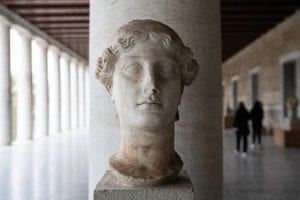The School of Liberal Arts warmly invites you to the Agora Speaker Series. Lectures presented as part of the series are free of charge and are open to members of the School of Liberal Arts, the University and the general public.
This series organises talks by internal and external academics, asking each speaker to deliver two talks: one aimed at undergraduates and the other at researchers. The talks take place every other week during teaching sessions.
Woman´s Bust, Stoa of Attalos, the museum of Ancient Agora, Athens, Greece
2020 PROGRAM OF EVENTS
MARCH
12 March – Prof Shaun Gallagher (University of Memphis/UOW)
26 March – Dr Talia Morag (University of Wollongong)
APRIL
9 April – Prof Dirk Baltzly (University of Tasmania)
23 April – Dr Anthony Hooper (University of Wollongong)
MAY
7 May – Dr Anik Waldow (University of Sydney)
21 May – Dr Elena Walsh (University of Wollongong)
AUGUST
6 August – Prof Stephen Hetherington (University of New South Wales)
20 August – Dr Bernardo Ainbinder (University of Wollongong)
SEPTEMBER
3 September – Prof Jennifer McMahon (University of Adelaide)
17 September – Dr Cathy Mason (University of Wollongong)
OCTOBER
8 October – Prof John Haldane (University of St. Andrews)
22 October – Dr Glenda Satne (University of Wollongong)
WHEN: THURSDAYS 3.30PM TO 5.30PM, LHA RESEARCH HUB, B19.2072
Further information on how to register to come.
‘Agora‘ (pronounced ‘ah-go-RAH’).
Courtesy of Encyclopaedia Britannica:
Agora, in ancient Greek cities, an open space that served as a meeting ground for various activities of the citizens. The name, first found in the works of Homer, connotes both the assembly of the people as well as the physical setting. It was applied by the classical Greeks of the 5th century BCE to what they regarded as a typical feature of their life: their daily religious, political, judicial, social, and commercial activity. The agora was located either in the middle of the city or near the harbour, which was surrounded by public buildings and by temples. Colonnades, sometimes containing shops, or stoae, often enclosed the space, and statues, altars, trees, and fountains adorned it. The general trend at this time was to isolate the agora from the rest of the town.
